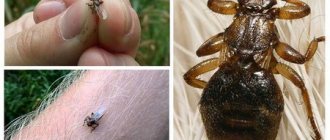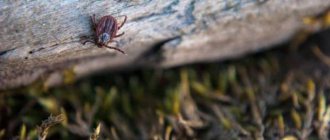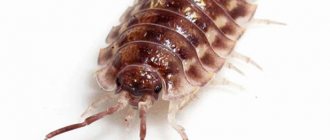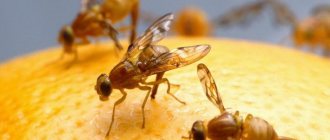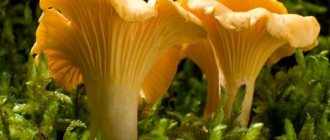What does an insect look like?
Locusts, a group of locusts, are a fairly large pest, 3 cm long and resembling a grasshopper.
Its elongated body is covered on the sides by hard elytra, often colored to match the area in which the insect lives. The color of individuals can be brown, yellowish or green .
The female has an ovipositor in the form of a pointed spike at the end of her body.
Interesting ! The color of locusts is camouflage. It is different even among closely related insects and depends not only on the type of pest, but also on the palette of the environment, the nature of nutrition, and humidity.
In the Asian locust, for example, even the gregarious and solitary forms have different appearances.
Description of locusts
Many have heard about how huge hordes of locusts literally destroyed the entire crop in the fields in a matter of minutes. What does this pest look like?
The body length of this voracious insect can range from 4.5 to 19.5 cm, its hind limbs are bent at the “knees”, and these limbs are much larger than the middle or forelimbs.
A pair of hard elytra cover half-transparent wings, almost invisible when folded. Sometimes the wings can be covered with patterns.
The antennae of this insect are short, much smaller than others. The head is larger than that of other individuals of this family, the eyes are larger than average.
Male locusts make specific sounds, how do they do it? It turns out that there are serrations on the thighs of the locust's hind limbs, and thickenings on the elytra. These parts rub against each other, resulting in a chirping sound that can vary in sound.
The body color of pests does not depend on their genes, but solely on the environment in which the locust lives. And even one offspring that grew up in different regions may have different body colors. Also, the color of the body can be determined by the shape of its development.
Young males and females can be bright emerald, yellow, gray or brown, which allows the pests to camouflage themselves among the surrounding vegetation. They also have pronounced differences by gender.
When individuals enter the gregarious phase of their development, their colors are already the same for all insects, and it is also impossible to distinguish them by gender. A flock of these insects moves briskly: these pests cover up to 100-115 km per day.
Photo
For a visual assessment of what locusts look like, photo below:
Locust and grasshopper: differences
Let's find out the difference between a locust and a grasshopper:
- The grasshopper's whiskers are longer than those of the locust and rise strongly above the head;
- Nature has awarded the grasshopper with longer limbs and massive hind legs - it is better adapted for jumping.
Despite their external similarity, these two insects belong to different orders - grasshoppers and locusts. The former are representatives of the long-whiskered suborder; the locust belongs to the short-whiskered suborder.
There are also differences in the lifestyle of the grasshopper and the locust:
- short mustaches are herbivores , and representatives of grasshoppers are predators;
- locusts are diurnal , raiding crops in broad daylight; long-legged jumpers are considered nocturnal insects;
- grasshoppers lay eggs on the ground parts of plants , and locust pests lay eggs in the soil.
Breeding
As long as you keep locusts in the right conditions, they are very easy to breed. She really needs high temperature, low humidity and lots of fresh food. If you have males and females, reproduction will occur naturally. You do not need to move the eggs or nymphs to another container. If you want, then of course you can. Nymphs are very small, so you can house them separately from their parents to care for them, prevent escapes, and make them easier to observe.
If you keep your locusts really well, you will get a lot of young larvae. Make sure this is actually what you need! If you do not want to breed locusts, remove the substrate with eggs or collect them and place them in the freezer. This will kill the eggs before they begin to develop. Never release locusts into the wild. It can cause an environmental disaster, disrupt the natural balance and compete with local species of locusts and grasshoppers.
What plants does it affect?
The pest is unpretentious in food , it eats the ground parts of vegetable plants, cereals, melons, attacks orchards, berry fields, wild trees, not disdaining reed plants.
Leaves, stems, shoots, even the bark of young trees serve as food .
You can learn more about the taste preferences of the merciless insect in the section devoted to its nutrition.
Interesting ! The older an insect gets, the more varied the food it eats becomes. Seasoned individuals are practically omnivorous.
Habitats and food
Various species of this pest can be found in almost any region of the globe (except the South Pole). Some species live in thickets of grass next to any bodies of water.
Others prefer desert or semi-desert climatic zones; they live in rocky areas where shrubs or grass grow.
What do locusts eat and how much can they eat? While the insect lives alone, its appetite is small. If an individual lives in one place, then it eats no more than 200-250 g of food of plant origin in its entire life.
But the locusts' appetite increases significantly the moment these pests flock together. The flock, flying along green spaces, eats everything in its path. After its invasion, bare earth remains without signs of any vegetation. Moreover, the flock usually stops for food in the morning and evening hours.
A swarm of these pests has no preferences in food - they destroy with the same appetite both thickets of reeds and reeds, as well as fruit trees and vineyards.
They also destroy plantings of any grain crops. During long flights, these insects can destroy weaker relatives, making up for the lack of food and water.
Kinds
There are several types of locusts, which differ in appearance and size. The name of the giant locust itself suggests that these insects have a record large size - up to 20 cm . The pest lives in the hot climate of South America.
In Russia, green locusts are found everywhere, resembling a grasshopper - an assistant to farmers and gardeners.
The inconspicuous omnivorous Moroccan pest is very dangerous due to its ability to quickly adapt to insecticides and cause great economic damage.
Capable of migrating in search of a climate suitable for reproduction, the desert locust is known for the fact that the amount of greenery consumed by an individual is equal to its weight .
Forms of development
The uniqueness of this insect lies in the fact that its development consists of two forms:
- Single (filly). This form of development is possible if there is a sufficient amount of food;
- Stadny. When food supplies become scarce, the fillies form flocks and go in search of food. A change in appearance occurs, the body and wings become larger, as individuals rub their limbs against each other, and there is a special organ on them. The fillies become locusts, a real disaster for humanity, capable of, with their huge hordes, devouring everything that is in the fields, orchards and orchards. In passing, the females lay eggs, from which locusts will emerge the next year, not fillies.
Locusts are a dangerous pest of agricultural land. There are “anti-locust organizations” in many countries, the largest one exists in the capital of Great Britain, which are developing all sorts of ways to combat locusts. However, in some southern countries, locusts are a delicacy and they breed them in special incubators.
Astrakhan scientists have developed a method for detecting locust larvae at an early stage of development:
Reproduction
Mating of pests in a favorable climate can occur from 5 to 12 times a year .
After mating and fertilization, the female lays eggs in the soil , from which larvae will be born after 2 weeks - smaller copies of adult insects.
In the section on locust reproduction you can see photos of insect eggs and larvae.
Interaction with people
Ancient times
A study of the literature reveals how common locust epidemics have been throughout history. Insects appeared unexpectedly, often after a change in wind direction or weather. Had devastating consequences.
The ancient Egyptians carved it on tombs (2470 – 2220 BC). A devastating plague of locusts is mentioned in the Book of Exodus of the Bible. Parasite invasions are mentioned in the Koran. In the ninth century BC, Chinese authorities appointed officers to combat it.
Aristotle studied locusts and their reproductive habits. Livy, 203 BC, Capua, recorded devastating invasions. He mentioned human epidemics after locusts, which he associated with the stench of rotten corpses.
The association of human disease outbreaks with locust epidemics is widespread. In the northwestern provinces of China, 311 AD, a plague epidemic was destroyed, which was caused by an increase in the number of rats (and their fleas) that devoured the carcasses of locusts.
Watch the video - locust invasion
Present tense
The main reported outbreaks occurred in Africa, the Middle East, and Europe. Since 1924, 173 outbreaks have been reported in China. The Bombay locust (Nomadacris succincta) is one of the main pests of India and Southeast Asia in the 18th and 19th centuries. Rarely swarmed after the last plague of 1908.
In the spring of 1747, locusts arrived outside Damascus. Ate most of the crops and vegetation of the surrounding area. A local hairdresser, Ahmad al-Budayri, recalled that “I came like a black cloud. Covered everything: trees, crops.”
The disappearance of the Rocky Mountain locust has become a source of confusion. In the 19th century, it covered the entire western United States and some areas of Canada.
Albert's 1875 swarm covered 198,000 square miles (510,000 km2), larger than California. Weighed 27.5 million tons with approximately 12.5 trillion insects. Last specimen seen alive in Canada, 1902.
Find out more 10 interesting facts about caterpillars that you never knew about
The insect's breeding grounds in the Rocky Mountain Valley were under sustained agricultural development during a large influx of gold miners, destroying the parasite's underground eggs.

